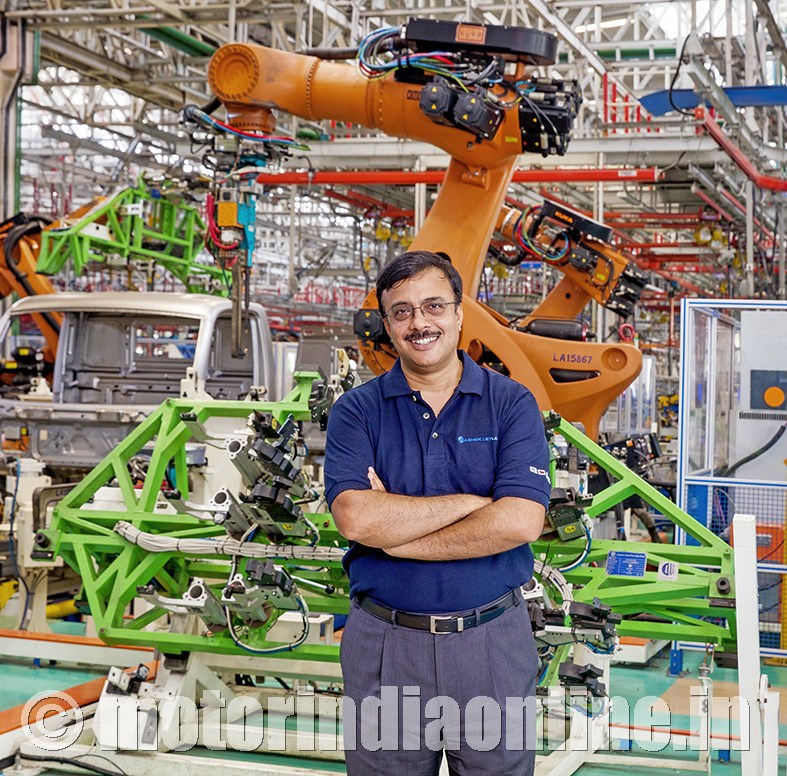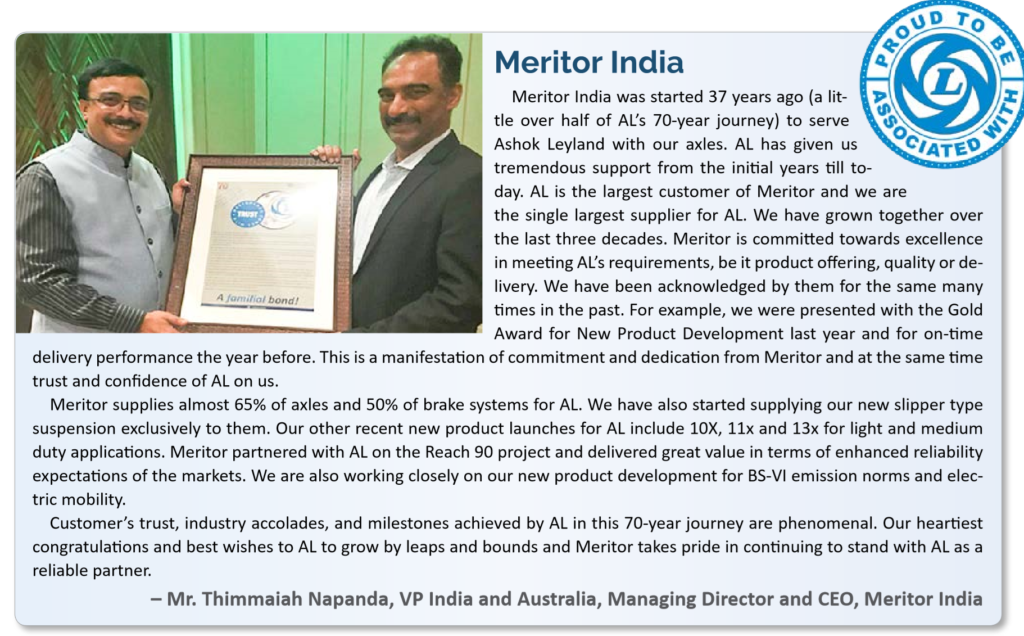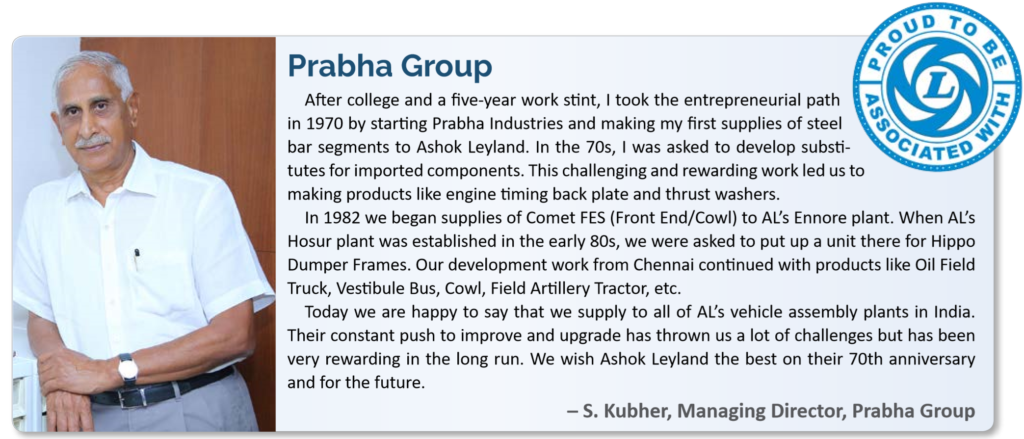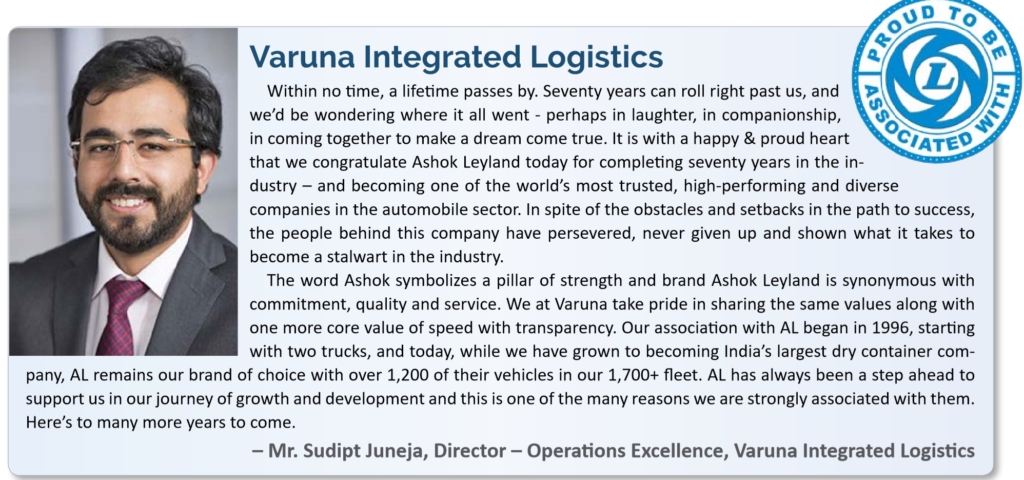“Ashok Leyland is probably the only CV player, a pure play Indian company in the domain. I think because we do not have the foreign DNA, we are uniquely Indian and can leverage on Indian ingenuity to come up with creative solutions,” remarks Mr. Vinod K. Dasari, Chief Executive Officer and Managing Director, Ashok Leyland Ltd. (AL), during an exclusive interview to MOTORINDIA on the occasion of the company stepping into the 70th year of its impressive journey in the mobility space.

Excerpts:
Congratulations on the occasion and, at this juncture, can you look back at the past 7 decades of AL’s interesting journey and share with us some of the milestones crossed and the inflection points that set the trend down the timeline?
I have been the MD for only 7 years in this great company that had been built over 7 decades by many people. The success of AL is a testament to the stewardship provided by previous managements, boards, promoters, and thousands of employees who have worked here. Companies go through cycles during the evolution, and there have been some distinct chapters during our journey as I look at it.
Our slogan ‘Aapki Jeet. Hamari Jeet,’ meaning ‘your victory is our victory’ captures only what we have done all along; and we have learnt this by talking to hundreds of employees and customers with us for over 25 years, and that’s the secret of our success. To put it short, the core values or ethos of AL has been to build a sustainable company and not just focus on financial performance, and the suppliers, dealers, employees communities and other stakeholders we come in touch with treat them with respect and pride.
Starting with Ashok Motors in 1948 to assemble Austin cars and associating later thro’ an agreement with Leyland UK to assemble and sell their trucks, the initial journey of the company started. Ashok motors became Ashok Leyland in 1955 and then commenced AL’s first phase of evolution with equity participation and technology support by Leyland UK, and the same continued till 1986.
Leyland UK was not doing well and at that time the shares were bought by the transnational conglomerate, the Hinduja Group and one of the leading CV players Iveco, with major stake 70% held by the Hindujas. During the second phase between 1987 and 2005, Iveco provided the technical support and various models were launched. The Hinduja Group subsequently bought the shares of Iveco and AL became a self-reliant Indian company in 2007.
During this third phase from 2008 till 2013, we invested a lot to become self-reliant. From 2014 onwards started our fourth phase wherein we embarked on future-ready platforms, new engines and cab range to meet the market needs based on the investments in the prior period.
The period 2011-14 marked a distinct transition for AL with external and internal developments. Tell us about the same and how AL gathered momentum to move into the fast lane.
It was during that time that many global CV players entered India. Unfortunately the market collapsed like never before, by about 25% in two successive years. The company had accumulated huge debt and what AL did was to go back to what the predecessors had created thro’ good stewardship, viz., a company with proud employees.
One of our competitors had fortunately, I reiterate, made a statement that they would bury AL. I approached the people with the message that we either fold up and leave or show to the competitor our true strength. Leveraging the pride factor built over the years, the plans were laid out to overcome the challenges for the growth path. 
My role was to connect the high-powered engine to the right pulley for pulling the company forward in the right direction. The task was to identify the people willing to take up the fight and put them on the battle field.
I cannot fight the battle alone and we needed a team to do it, and we overcame the situation with flying colours. We have moved over since then from an average company on the brink of financial collapse to a good company now. The task on hand is to take it to the level of a great company in the next 5 years.
Also we did the right things to address the situation. As a first measure, companies in trouble move to cut costs and the mistake they make is stop at that. You can never achieve sustainable long-term success only thro’ such a measure. Yes, we did cut down costs on various fronts, but over and above that, we invested a lot in growth. During those times, the highest number of new products came out. We invested a lot in net worth. We have many subsidiaries and invested in various businesses.
However, our vision as, laid down by our Chairman Mr. Dheeraj Hinduja, states nothing but to be in the M&HCV segment globally amongst top 10 in trucks and top 5 in buses in volume terms. It does not talk about anything else. Hence keep looking at it was my Chairman’s succinct message. What does a customer with many trucks or buses really want? Though his requirements may be many, he basically needs the wheels of the truck to keep rolling, and once it stops, wants to get into the workshop for repairs and move out fast.
Also, he wants genuine spare parts and excellent service at the workshop. We addressed the issue on a priority basis and it was one of many such we had done it differently during the difficult times.
Can you apprise us of the hits and misses in your rebuilding program, the projects undertaken and those in the pipeline to address the growing market demands?
One of the secrets of success is to celebrate even a small success. We have several performance awards at various levels, spouses’ competition and the prestigious Chairman’s Award to sustain the interest for the contribution and make a difference. Internally we have done a lot like performance differentiation and leadership development programs. During a huge transformation exercise some measures will work and some others will not. The approach has been not to dwell on the failures but move on.
Trucks, buses, LCVs are in our core line; Defence and spare parts are add-ons; we are in Power solutions because we know how to make world-class engines; and EVs are nothing but variants in CVs. The rest are non-core areas. There have been several non-core businesses wherein we are doing well and, in some cases, took the sick ones back on track. But it sucks out a lot of management time in doing so, and hence we keep asking ourselves whether we are the right owners for such a business.
We have a new intangible metric for the team in connection with any of the new proposals simply put as to whether we can have the ROTI, viz., Return On Time Invested. This helps people to stay focused on the core lines.
We have developed a huge digital platform for various driver assist applications. iAlert for vehicle monitoring, Leykart for spares and Service Mandi, an agnostic service platform, are some of the programs launched. In the past, we have also built physical infrastructure for dealers and now created the digital infrastructure for them. The digital aftermarket platform launched is growing at 30%, and with the way we can interact with the vehicles, enormous opportunities are opening up on the digital front.
We have done repowering battle tanks and focussing on what the Army needs but all connected to mobility. We have done very well in the LCV business and will be investing Rs. 500 crores in the Nextgen launches during 2020. Also the trucks will be on modular platform and, like a lego set, different parts can be assembled to get the desired product. We already have a truck assembled thro’ the modular platform route undergoing BS-VI trials.
We want to be the best in whatever we undertake and nothing stops us in becoming a leading global CV player in line with our vision. I spend about 40% of my time on ‘next 5 years’, 40% on ‘people’, and the balance on routine things to steer the company towards the above goal. I am truly blessed to have a great team which runs the show.
Brief us on the company’s moves to address the missing links like the multi-axle bus in the product program and export markets, especially the advanced countries like the US, against global competition?
It’s a small market for multi-axle buses and we have a team working on it. When I pose that question of ROTI, the answers invariably point to a niche segment in the domain; and the initiative to go for it arises more from the market leader not having it in the product program. I also get the suggestions that the company can do it a lot cheaper with comparable features and standards, but I have made one thing clear to them. When the product comes out, it has to be world-class and there shall be no compromise of features for a lower price.
The same criterion we have followed for launching the Oyster bus in the Middle-East at Japanese prices, with even better quality and features. For addressing the export markets, especially in the EV domain, we will leverage the Optare brand to do it. Recently they have bagged the world’s first electric double-decker order for transport in London.
Future course for the company will be defined by people and the HR has been tasked to create 100 CEOs to start various businesses and also identify women talent at various levels to lead the organization. In this direction we have recruited girl students from IITs at the entry levels and our Pant Nagar plant is having 30% women at different levels. As the resources, be it of any type, move from one of scarcity to plenty, I opine women will perform better than men, and AL has already taken steps in this direction for the future.